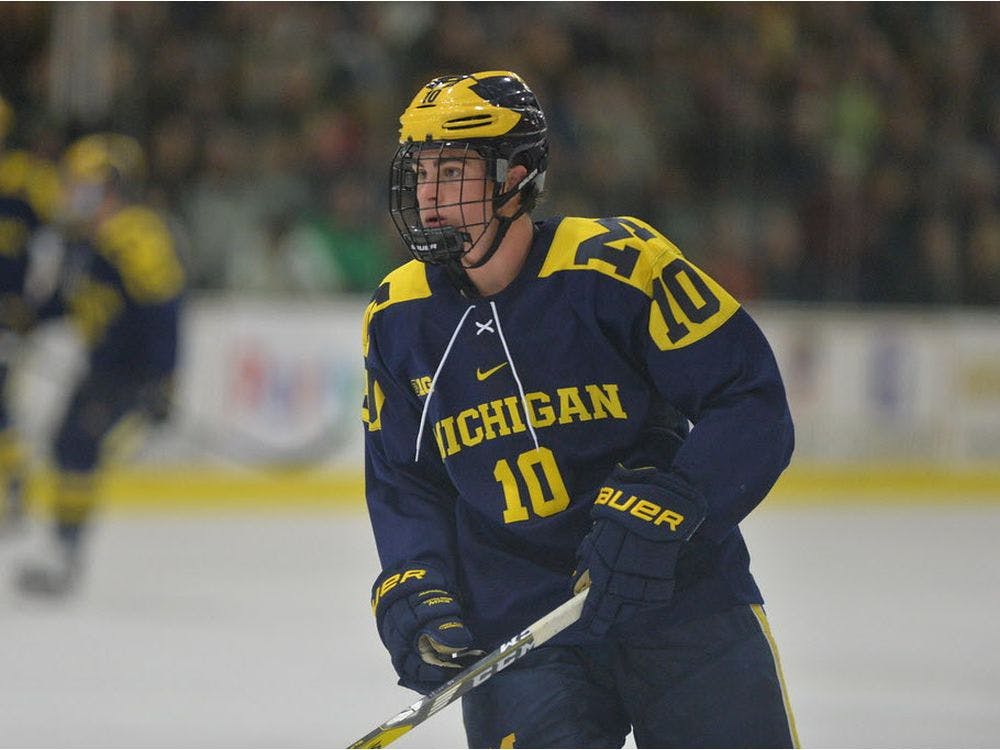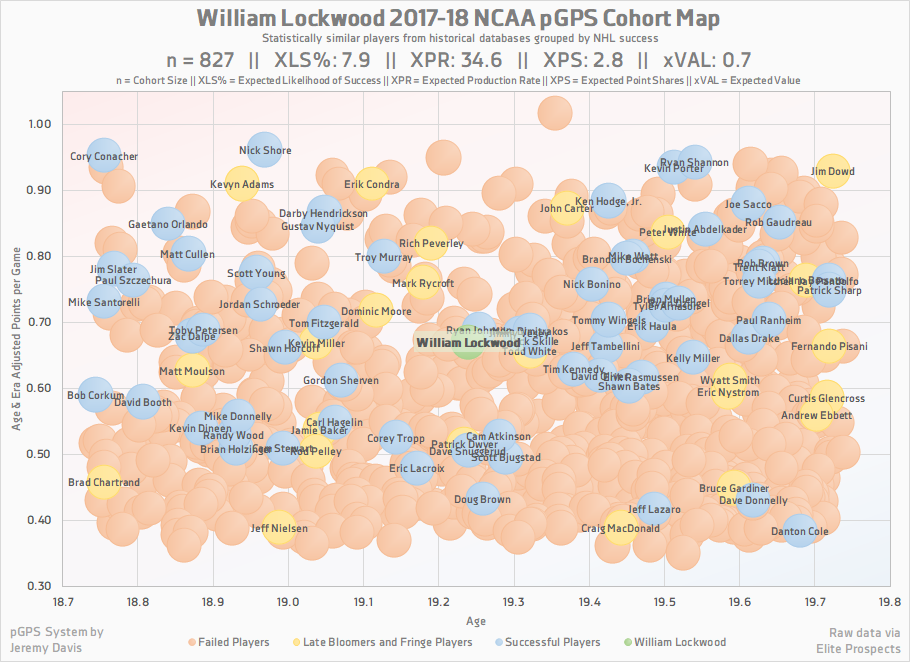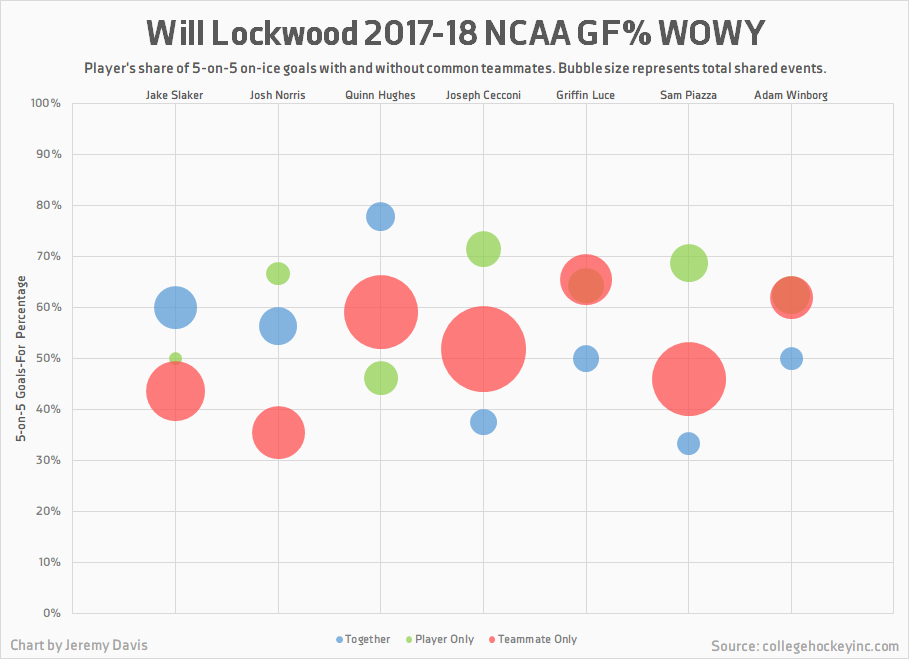CanucksArmy’s 2018 “Midterm” Prospect Rankings: #9 Will Lockwood

5 years ago
Will Lockwood is a confusing player. It was confusing when the Canucks selected him over a full round earlier than he was projected to go. It was confusing when his scoring rates skyrocketed the following year in a tougher league against tougher competition. And now, with a 16-game sample to draw from and a potentially career-altering injury, it’s more than a little confusing trying to divine what direction he’s headed in. Regardless, his projectable toolkit and impressive rookie NCAA season were enough to land him in the ninth slot on our midterm prospect rankings.
Numbers
After seeing his expected likelihood of success percentage by the prospect Graduation probabilities system (pGPS) skyrocket from 1.8% to 17.5% after his stellar rookie season in the NCAA, Lockwood’s numbers have taken a significant dip. It’s important to remember that his sophomore season consisted of only 16 games, so it’d difficult to draw conclusions based on that sample.

When looking at his most recent season, Lockwood has an expected success percentage of 7.9%. Most of Lockwood’s successful cohorts carved out their careers as bottom-six forwards but there were some notable offensive producers among his matches, including Patrick Sharp, Gustav Nyquist, Cam Atkinson, and Carl Hagelin.

Overall, Lockwood had a positive impact on his teammates’ ability to create offence, although once again it is important to note the small sample size.


Scouting Report
Failed to load video.
Watching a highlight package from either of Lockwood’s two seasons in the NCAA could easily give one the impression that he is a potentially elite player. The first word that comes to mind with regards to Lockwood is “tools”. He’s got them, in spades. He’s great with the puck, has a sneaky wrist shot, and the ferocity of a player much larger than his modest 5’11” frame. His biggest asset, however, is his skating ability. Lockwood is among the fastest skaters in the Canucks’ pool, a skill that he frequently uses to his advantage. His acceleration is rapid and he is frequently able to separate himself from defenders on the forecheck. He is particularly adept at generating breakaways, and has scored a number of his goals off of individual efforts. Lockwood does a lot of his damage in the neutral zone, something J.D. Burke was able to make note of tracking zone entries for HockeyData Inc, which he discussed in his preseason profile:
Under the watchful eye of Wolverines head coach Red Berenson, Lockwood seems to have refined his game in a way that leads to sustained offence. As Jeremy Davis noted in his excellent mid-season profile, Lockwood (in an admittedly small sample) is using his speed to push play in the neutral zone with controlled entries at the highest rate on his entire team. A testament to Lockwood’s defensive commitment, he led all Wolverines forwards in controlled zone exits as well — he wasn’t flying the zone or cheating to create offence.One thing Lockwood’s always done well is apply his speed in puck retrieval. Canucks general manager Jim Benning’s comparison to Hansen holds up especially well in this light.
Unfortunately, Lockwood could also be a case study in why it’s important not to judge a prospect based simply on his best moments. Lockwood’s highlight package is filled with an inside-outside fake he loves to pull on defenders. When it works, it looks amazing. When it doesn’t, it results in a turnover, and looks more silly than impressive. This is a fairly consistent issue with Lockwood offensively. He loves to hold on to the puck – and he’s very good at it- but sometimes he holds onto it a little too long, and his speed can often cause him to skate the puck into trouble rather than out of it. For Lockwood to truly unlock his offensive potential, he will need to learn to use his linemates more consistently and rely on hockey sense rather than pure speed to make plays.
By the same token, there are positive attributes that don’t necessarily show up in a highlight package, either. Lockwood has a very strong two-way profile, is responsible defensively, and plays on both special teams for the Wolverines. He’s also extremely feisty and unafraid to take on much larger players in the corners and along the boards. It’s an admirable quality; but it’s also part of the reason Lockwood’s had shoulder surgery, twice. He sustained a season-ending injury at the World Juniors in January, and it’s difficult to know how Lockwood will recover. He’s missed some significant development time, which makes him a prime candidate to fall down the prospect rankings come September. Still, he’s flashed upside over his NCAA career, and it’s entirely possible that the Canucks found a diamond in the rough in 2016 drafting a forward out of the USHL. It wouldn’t be the first time.





